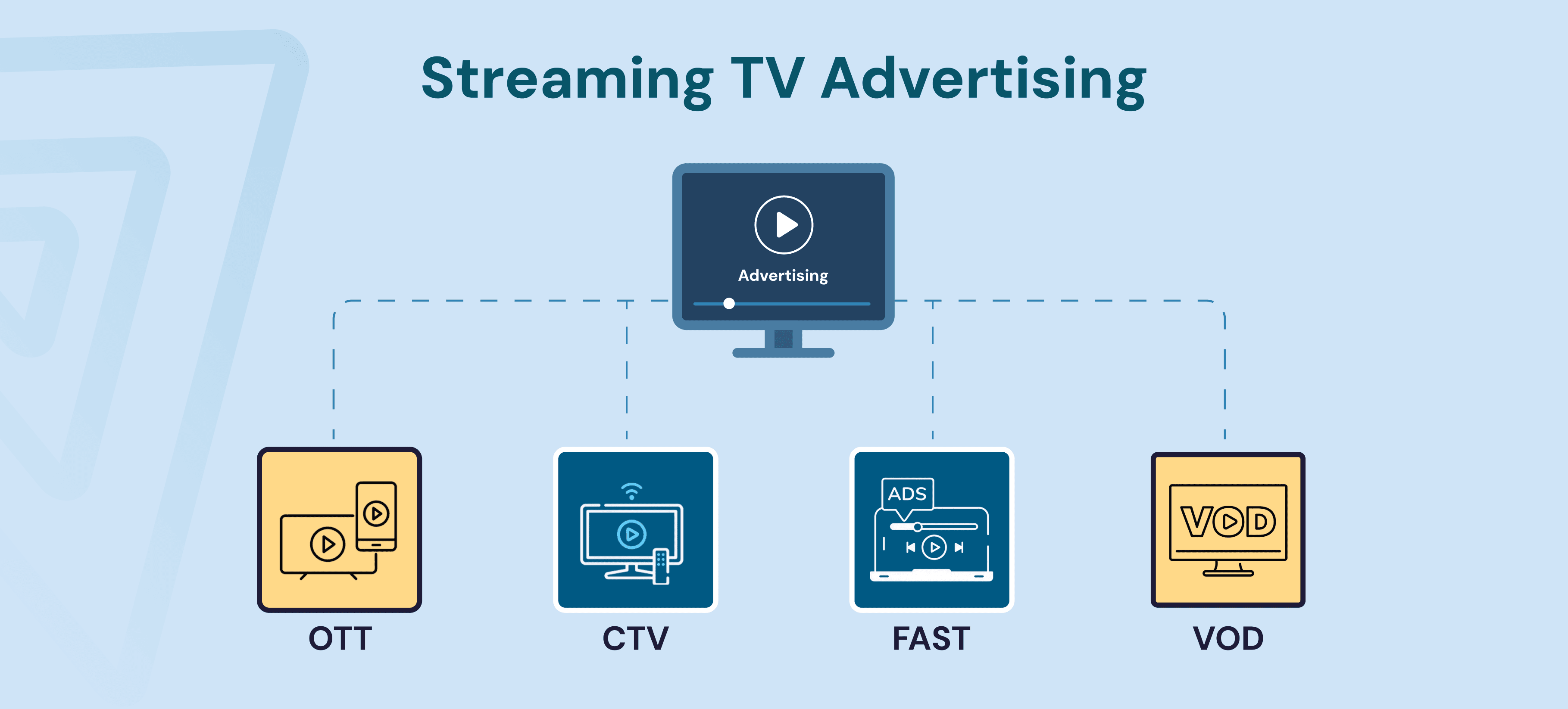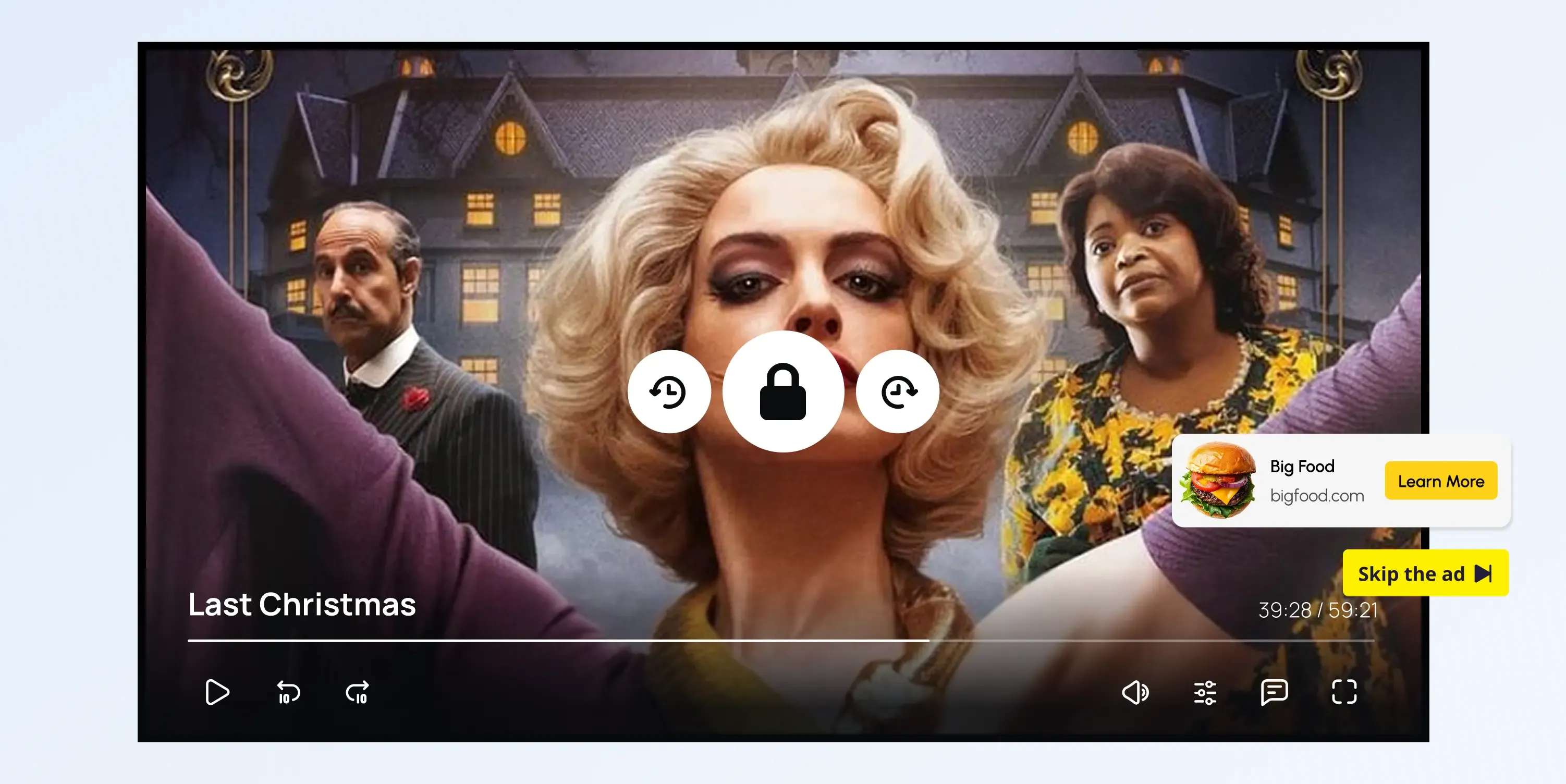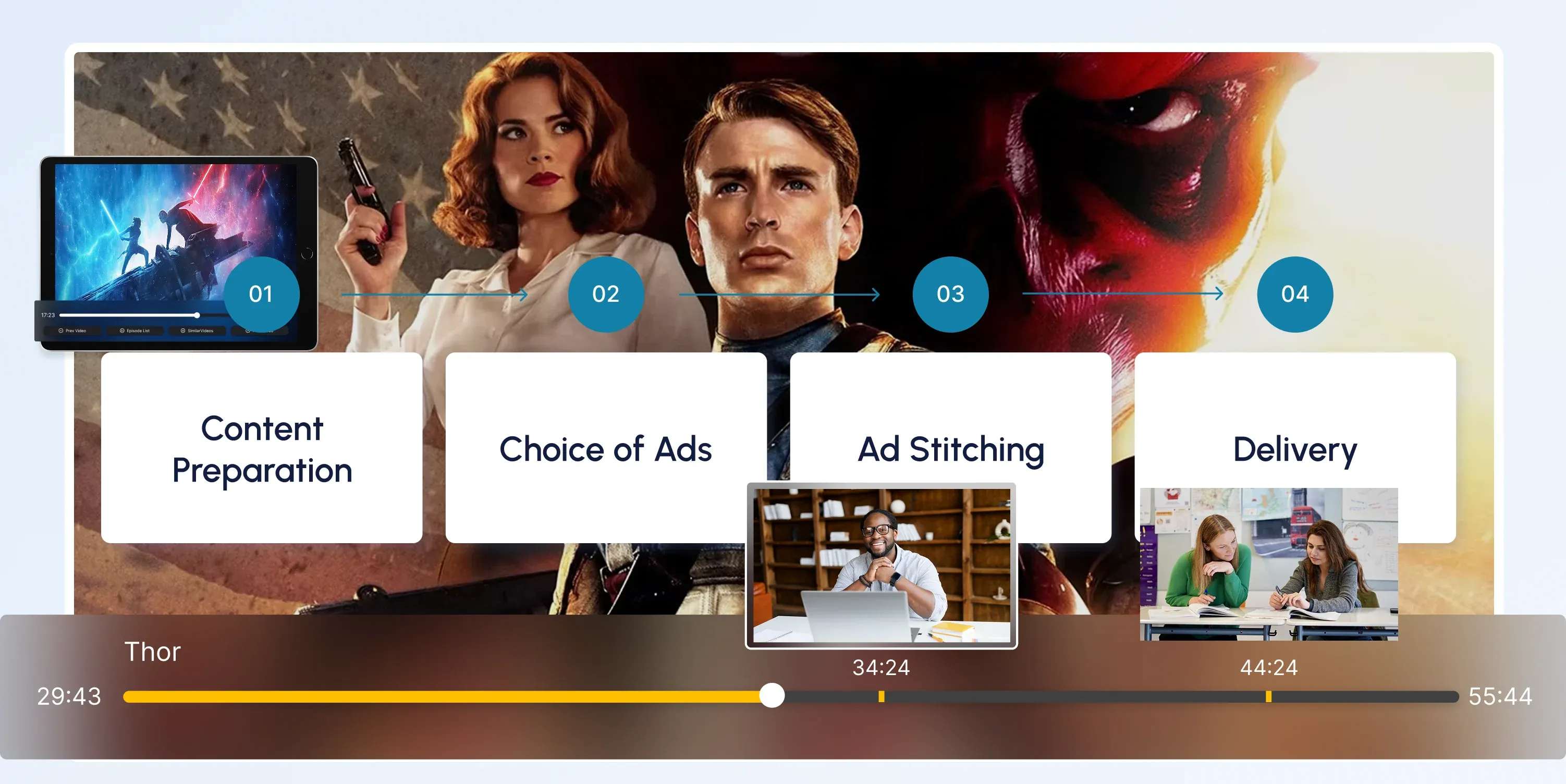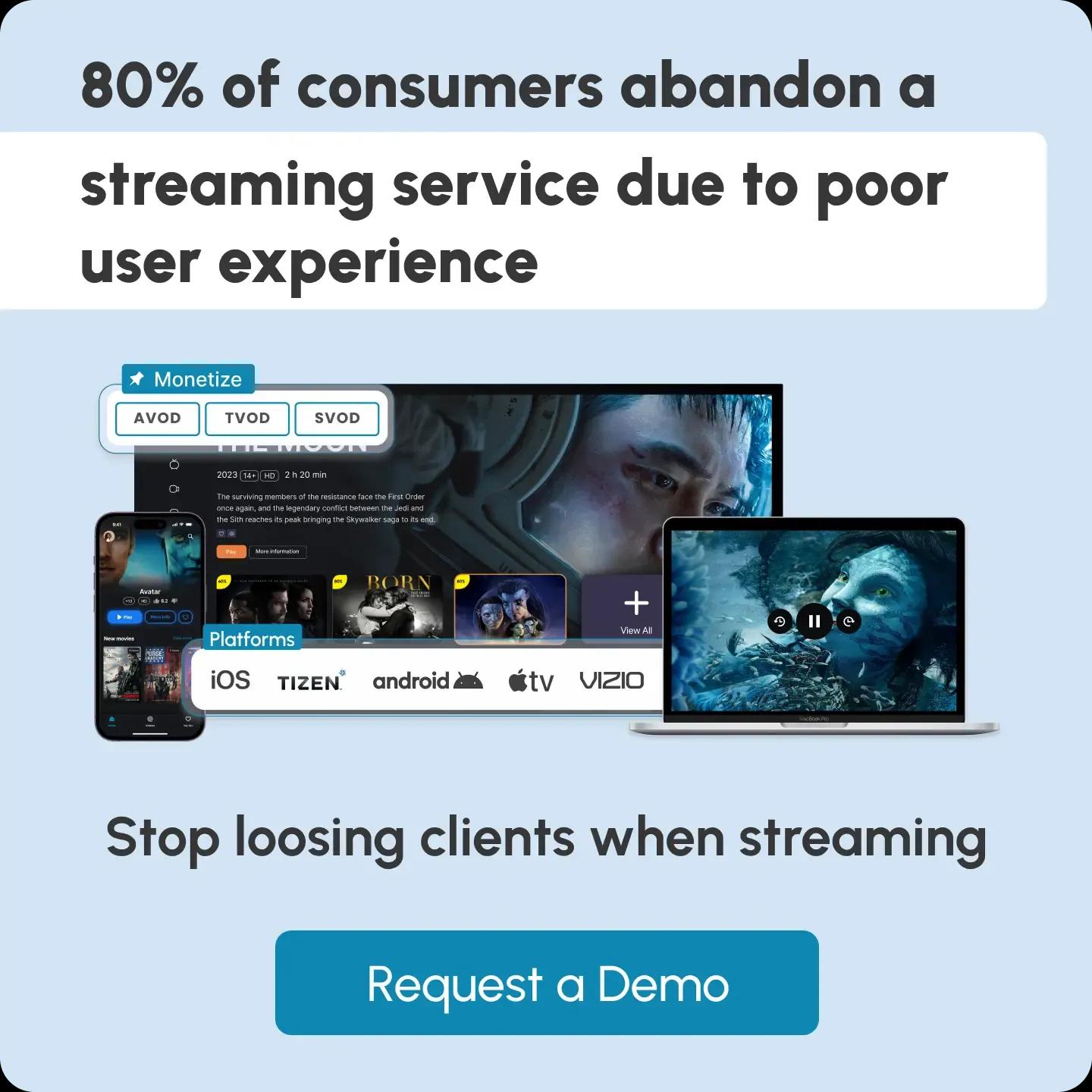Glossary term
Streaming TV Advertising

What Is Streaming TV Advertising?
Streaming TV advertising is an umbrella term. It covers any form of advertising delivered through internet-based TV content across OTT platforms, CTV devices, VOD apps, and FAST channels.
Simply put, all advertising shown inside streamed video content on internet-connected TVs or apps falls under Streaming TV advertising.
 When viewers watch content via internet-connected TVs or apps (instead of cable or satellite), every ad format that appears in that environment is considered streaming TV advertising. This makes streaming TV advertising broader than just “TV-style commercials.”
When viewers watch content via internet-connected TVs or apps (instead of cable or satellite), every ad format that appears in that environment is considered streaming TV advertising. This makes streaming TV advertising broader than just “TV-style commercials.”
Streaming TV Advertising Is Not the Same as CTV
CTV (Connected TV) is often used interchangeably with Streaming TV, because platforms refer to streaming TV ads as CTV for short. But this is not technically correct. As we explained above, CTV is just a part of streaming TV advertising.
Learn more about CTV here.
How Does Streaming TV Advertising Work?
Streaming TV advertising includes both technical and marketing-related steps. We will guide you through each step, provide examples, and outline the key purpose of each step. Here is how everything combined works.
1. Content Creation and Preparation
First, the content (TV shows, movies, or live events) is produced and then digitized. To support multiple devices and internet speeds, the raw video is transcoded into different resolutions and bitrates (e.g., 240p up to 4K). If needed, subtitles or closed captions are added for accessibility.
Finally, some providers might apply DRM (Digital Rights Management) to prevent piracy.
This step ensures device compatibility, accessibility, and security.
2. Storage and Content Management
Back to the transcoded video content. It gets encoded and stored in a secure CMS (Content Management System) or video platform. Each file gets metadata like title, description, categories, and thumbnails. Playlists and content libraries are organized so apps can present them to users in an easy-to-use UI.
This step focuses on the discoverability of the content and makes navigation in the app easy and fast.
3. Distribution and Delivery (CDN)
At this stage, the video content is ready to be shared with users. To make delivery possible, videos are uploaded to origin servers and replicated through a CDN (Content Delivery Network) with edge servers worldwide. When a viewer hits “play,” the closest CDN server responds.
Example:
If you’re in Paris and the content is hosted in New York, a CDN ensures you still get smooth playback from a local European server.
So, CDNs are responsible for fast, smooth, and reliable streaming.
4. Streaming Protocols and Packaging
At this stage, videos are broken into small chunks (2–10 seconds) using streaming protocols like HLS (HTTP Live Streaming) or MPEG-DASH. Then, with ABR (adaptive bitrate streaming), the player automatically switches between HD, SD, or 4K based on your internet speed.
Example:
If your Wi-Fi drops from 50 Mbps to 5 Mbps, the stream continues in lower quality instead of buffering.
Streaming protocols are responsible for continuous playback. These carry the “rules” by which the stream quality is adjusted to your connection.
5. Access and Playback
The viewer opens a streaming OTT app on a CTV device such as a Smart TV, Roku, Fire TV, Apple TV, PlayStation, or mobile. The app requests the video manifest file (playlist of chunks) and starts fetching the segments. The player buffers a few seconds ahead to keep playback smooth and uninterrupted.
Example:
You can start a 2-hour movie instantly without needing to download it in full.
This stage focuses on ensuring instant streaming on any device.
6. Ad Insertion
If the content is about to be monetized, this step can’t be skipped.
For ad-supported platforms (AVOD or FAST), ads are inserted in two ways:
- SSAI (Server-Side Ad Insertion): Ads are stitched into the stream before delivery (on the server), making them seamless and harder to block.
- CSAI (Client-Side Ad Insertion): The app requests ads and plays them at set points, giving more flexibility. The only downside is that it's easier for ad-blockers to detect.
Learn more about SSAI and CSAI.
Once the ad is inserted with one of the methods above, it’s time to decide where it will appear. Ad servers, DSPs (Demand-Side Platforms), and SSPs (Supply-Side Platforms) decide in real-time which ads to play based on targeting data.
Example:
You might see a sneaker ad, while your friend, who is watching the same show, sees a car ad (all based on who prefers what).
So, ad insertion ensures personalized and monetized streaming experiences.
7. Viewer Experience
The content is on the screens, plays smoothly, with automatic resolution changes if the internet speed fluctuates. Ads appear in pre-roll, mid-roll, or pause moments depending on the platform’s model.
Personalization engines suggest shows based on your viewing history, favorite genres, and watch time.
Example:
After watching one sci-fi movie, the platform recommends more titles in the same genre.
So, the viewer experience ensures seamless playback and tailored recommendations.
8. Measurement and Analytics
These show platforms how viewers engage with both content and ads. Every stream and ad interaction is logged, including impressions, completion rates, buffering incidents, and churn. This data feeds back into both recommendation systems (to suggest new shows) and ad engines (to deliver more relevant ads).
Example:
Watching a sci-fi show could lead to 10 more sci-fi recommendations and an ad for “Star Wars” merchandise.
So, analytics ensure platforms optimize both content discovery and ad targeting.
9. Monetization and Business Models
And finally, the best part: monetization. Streaming TV operates under several business models:
- SVOD (Subscription VOD): Viewers pay a monthly fee, usually ad-free (e.g., Netflix, Disney+).
- AVOD (Ad-Supported VOD): Free or cheaper, supported by ads (e.g., Peacock, YouTube).
- FAST (Free Ad-Supported Streaming TV): 100% free, structured like linear TV with ads (Pluto TV, Tubi).
- Hybrid models (HVOD): Combine subscriptions with ads for flexibility (e.g., Hulu, HBO Max).
Example:
On Hulu, you may pay a lower subscription fee but still see mid-roll ads during shows.
Monetization models determine how streaming platforms earn revenue.
Real-Life Example of Streaming TV Advertising: Watching a Show on Hulu (Ad-Supported Tier)
Let’s say Hulu licenses The Bear from FX and transcodes it into multiple resolutions (1080p, 720p, 480p). First, the platform uploads the episode to its CMS with metadata like title, description, and episode number, then it pushes the files to CDNs worldwide. The published video is segmented into 6-second HLS chunks with adaptive bitrates, ready for delivery.
So, when you open the Hulu app on your Roku TV and click The Bear, the app requests the manifest file containing all the data the system needs to deliver content in the best quality possible.
Before playback, Hulu’s ad server requests an ad, and you see a 15-second Coca-Cola spot delivered via SSAI, stitched directly into the stream. And finally, the episode begins, and midway through, you get another mid-roll ad break.
If your Wi-Fi slows, the player automatically shifts quality to 720p.
Hulu records that you watched 95% of the episode and completed both ads, earning revenue from your subscription fee and from the advertiser who paid for the Coca-Cola placement.
Ad Formats in Streaming TV Advertising
Here is a list of all ad formats that can be used in streaming TV advertising:
1. Pre-Roll Ads: Short ads that play before the main content starts.
Example: A 15-second car ad before your show begins.
2. Mid-Roll Ads: Ads inserted during natural breaks in content (like TV commercial breaks).
Example: Ads that appear halfway through a 40-minute episode.
3. Post-Roll Ads: Ads that play after the content ends. These are less common, but still used for brand reinforcement.
4. Binge Ads: Ads triggered when viewers watch multiple episodes in a row.
Example: “Watch this 30-second ad to stream the next episode ad-free.”
5. Pause Ads: Static or video ads shown when viewers pause content.
Example: A banner for Coca-Cola when you hit pause.
6. Overlay or Banner Ads: Small clickable banners overlaid during playback or in app menus.
Example: Lower-third banners during sports streaming.
7. Interactive and Shoppable Ads: Viewers can interact with ads using their remote, QR codes, or clicks.
Example: Scan a QR code on-screen to buy the sneakers shown in the ad.
8. Homepage and Menu Ads: Ads on the streaming app’s interface before content plays.
Example: Featured sponsor banners on Roku’s home screen.
Streaming TV Advertising vs Traditional TV Ads
If you’ve come this far, it’s already clear: streaming TV ads have a significant advantage over traditional advertising. So, what are the key features that make streaming TV ads the winner?
This comparison table has the answer:
| Aspect | Streaming TV Advertising | Traditional TV Advertising |
|---|---|---|
| Delivery | Internet-based, delivered via OTT, CTV, VOD, or FAST platforms | Broadcast or cable transmission through satellite and cable networks |
| Targeting | Highly targeted using data (demographics, interests, location, behavior) | Broad audience targeting based on channel, program, or time slot |
| Ad Formats | Pre-roll, mid-roll, pause ads, binge ads, overlays, interactive, shoppable | Standard 15–60 second TV commercials during scheduled breaks |
| Flexibility | Ads can be personalized, dynamic, and changed in real time | Ads are fixed once scheduled and cannot be easily updated |
| Measurement | Digital metrics: impressions, clicks, completion rates, conversions | Panel-based estimates (e.g., Nielsen ratings) are less precise |
| Devices | Smart TVs, streaming devices, consoles, mobiles, tablets, and desktops | Traditional television sets only |
| Viewer Control | Viewers choose what to watch and when; ads fit within on-demand or free streaming | Viewers follow fixed programming schedules with scheduled ad breaks |
| Cost Model | Often lower entry cost, with programmatic buying and flexible budgets | High upfront cost for production and placement, limited flexibility |
| Examples | Hulu, Netflix (ads), YouTube, Pluto TV, Roku Channel | NBC, CBS, ESPN, CNN, traditional cable bundles |
In Short:
Streaming TV ads are precise, flexible, measurable, and digital-first.
Traditional TV ads are broad, but less targeted, and more expensive.
Platforms That Use Streaming TV Advertising
Streaming TV advertising runs across a wide variety of platforms. These include:
OTT services: Hulu, Netflix (ads tier), Peacock, Disney+, and YouTube
FAST channels: Pluto TV, Tubi, and The Roku Channel
CTV devices: Roku, Amazon Fire TV, Apple TV, and Smart TVs from brands like Samsung and LG
Live sports platforms: ESPN+, DAZN
Hybrid apps: Twitch
5 Benefits of Streaming TV Advertising
- Precise Targeting: Deliver ads based on demographics, interests, location, and device type.
- Measurable Outcomes: Track performance in real time through impressions, completion rates, and conversions.
- Cost Efficiency: Optimize ad spend with flexible budgets and programmatic buying.
- Transparency and Flexibility: Easily adjust campaigns with precise performance data.
- Higher Engagement: Use personalized, interactive, or shoppable ads to capture audience attention.
Streaming TV Advertising in the OTT Ecosystem
Within the OTT ecosystem, streaming TV advertising plays a central role in funding ad-supported and hybrid models. Services like AVOD (ad-supported video on demand) and FAST (free ad-supported streaming TV) rely entirely on ads to remain free for users, while hybrid platforms like Hulu and HBO Max balance lower subscription costs with ad revenue.
Streaming TV advertising enables OTT providers to combine subscription income and ad placements, expand reach, reduce churn, and maintain profitability. So, it holds the most important aspects of the OTT ecosystem.
Frequently Asked Questions
Content Writer
Anush Sargsyan is a content writer specializing in B2B content about OTT streaming technologies and digital media innovation. She creates informative, engaging content on video delivery, OTT monetization, and modern media technologies. The goal is to help readers easily understand complex ideas. Her writing is the bridge between technical detail and practical insight, making advanced concepts accessible for both industry professionals and general audiences.
Related terms

AVOD (Advertising-Based Video on Demand)
Explore how AVOD works, its monetization model, and why it's popular for free streaming platforms. Read the full definition on inorain.com glossary.

CSAI (Client-Side Ad Insertion)
Learn how CSAI delivers ads through the video player, enabling targeting, tracking, and monetization.

